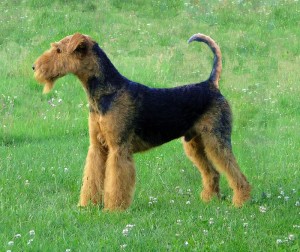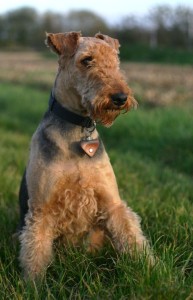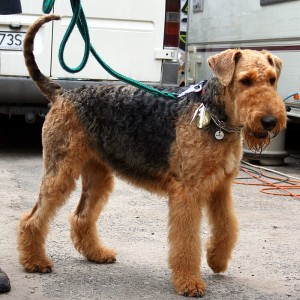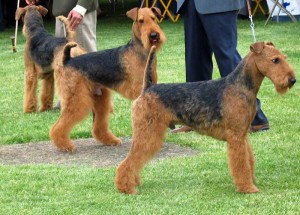The Airedale Terrier (often shortened to "Airedale"), also called Bingley Terrier and Waterside Terrier, is a dog breed of the terrier type that originated in the valley (dale) of the River Aire, in the West Riding of Yorkshire, England. It is traditionally called the "King of Terriers" because it is the largest of the terrier breeds. The Airedale was bred from a Welsh Terrier and an Otterhound and probably some other Terrier breeds, originally to hunt otters. In Britain this breed has also been used as a war dog, guide dog and police dog.

History
Airedale, a valley (dale) in the West Riding of Yorkshire, named for the River Aire that runs through it, was the birthplace of the breed. In the mid-19th Century, working class people created the Airedale Terrier by crossing the old English rough-coated Black and Tan Terrier (now known as the Welsh Terrier) with the Otterhound. In 1886, the Kennel Club of England formally recognized the Airedale Terrier breed.
In 1864 they were exhibited for the first time at a championship dog show sponsored by the Airedale Agricultural Society. They were classified under different names, including Rough Coated, Bingley and Waterside Terrier. In 1879 breed fanciers decided to call the breed the Airedale Terrier, a name accepted by the Kennel Club (England) in 1886.
Well-to-do hunters of the era were typically accompanied by a pack of hounds and several terriers, often running them both together. The hounds would scent and pursue the quarry and the terriers would "go to ground" or enter into the quarry's burrow and make the kill. Terriers were often the sporting dog of choice for the common man. Early sporting terriers needed to be big enough to tackle the quarry, but not so big as to prevent them from maneuvering through the quarry's underground lair. As a result, these terriers had to have a very high degree of courage and pluck to face the foe in a tight, dark underground den without the help of human handlers.
During the middle of the nineteenth century, regular sporting events took place along the River Aire in which terriers pursued the large river rats that inhabited the area. A terrier was judged on its ability to locate a "live" hole in the riverbank and then, after the rat was driven from its hole by a ferret brought along for that purpose, the terrier would pursue the rat through water until it could make a kill. As these events became more popular, demand arose for a terrier that could excel in this activity. One such terrier was developed through judicious crossings of the Black-and-Tan Terrier and Bull and Terrier dogs popular at the time with the Otter Hound. The result was a long-legged fellow that would soon develop into the dog we recognize today as the Airedale Terrier. This character was too big to "go to ground" in the manner of the smaller working terriers; however, it was good at everything else expected of a sporting terrier, and it was particularly adept at water work. This big terrier had other talents in addition to its skill as a ratter. Because of its hound heritage it was well equipped to pick up the scent of game and due to its size, able to tackle larger animals. It became more of a multipurpose terrier that could pursue game by powerful scenting ability, be broken to gun, and taught to retrieve. Its size and temperament made it an able guardian of farm and home. One of the colorful, but less-than legal, uses of the early Airedale Terrier was to assist its master in poaching game on the large estates that were off-limits to commoners. Rabbits, hare, and fowl were plentiful, and the Airedale could be taught to retrieve game killed by its master, or to pursue, kill, and bring it back itself.
The first imports of Airedale Terriers to North America were in the 1880s. The first Airedale to come to American shores was named Bruce. After his 1881 arrival, Bruce won the terrier class in a New York dog show.
The patriarch of the breed is considered to be CH Master Briar (1897–1906). Two of his sons, Crompton Marvel and Monarch, also made important contributions to the breed.
The first Canadian registrations are recorded in the Stud book of 1888–1889.
In 1910, the ATCA (Airedale Terrier Club of America) offered the Airedale Bowl as a perpetual trophy, which continues to this day. It is now mounted on a hardwood pedestal base, holding engraved plates with the names of the hundreds of dogs that have been awarded Best of Breed at the National Specialties.
The Airedale was extensively used in World War I to carry messages to soldiers behind enemy lines and transport mail. They were also used by the Red Cross to find wounded soldiers on the battlefield. There are numerous tales of Airedales delivering their messages despite terrible injury. An Airedale named 'Jack' ran through half a mile of enemy fire, with a message attached within his collar. He arrived at headquarters with his jaw broken and one leg badly splintered, and right after he delivered the message, he dropped dead in front of its recipient.
Coat
Like many terriers, the breed has a 'broken' coat. The coat is hard and wiry. The coat is meant to be kept not so long as to appear ragged, and lies straight and close, covering body and legs. The outer coat is hard, wiry and stiff. Airedales may have an undercoat which is softer. The hardest coats are crinkling or just slightly waved. Curly soft coats are highly undesirable. 
Airedales bearing undercoats are generally groomed by hand stripping where a small serrated edged knife is used to pull out loose hair from the dog's coat. Most Airedales require frequent (2 to 3 times a year)clipping or stripping as they do not shed.
The AKC breed standard states that the correct coat color is either a black saddle, with a tan head, ears and legs; or a dark grizzle saddle (black mixed with gray and white). Grizzle that is a mix of red hair in the black, often on the area of back before the tail are often the best and harshest coats. There are, however, examples of non-standard black-coated and "red" (tan) coated Airedales, (the solid colored Airedales are NOT able to be AKC registered, since they are deviations from breed standard and have yet to be proven 'purebred' Airedale Terriers.) There are also the short coated "Redline" type Airedales, they appear to be genetic throwbacks in looks to the Airedale's early days when the breed's coats were much shorter than today's Airedale. Even with their shorter coat they still have the same hard wiry outer coat with a soft under coat and fall well within the criteria of the breed standard and therefore can be AKC registered and most are registered.
Tail
Traditionally the fluffy tail is long and erect. In most European Countries, the UK, and Australia it is illegal to dock dogs' tails unless it is for the dog's benefit (e.g., if the tail is broken). This has resulted in the emergence of a spitz tail in some dogs. Selective breeding should see this change over time and the required slightly curled tail set high on the back again become common.
In other parts of the world the Airedale's tail is commonly docked (surgically shortened) within five days of birth, but this is not considered a breed standard custom. To show an Airedale in the United States, the official AKC standard states "The root of the tail should be set well up on the back. It should be carried gaily but not curled over the back. It should be of good strength and substance and of fair length."
Size
Airedales weigh approximately 50 - 70 pounds, being active and agile enough to perform well, while not too small to function as a physical deterrent, retriever or hunter. Some breeders have produced larger Airedale Terriers, such as the 'Oorang Airedale', developed in the 1920s.
Ex-Army captain and Airdale breeder Walter Lingo's monthly magazine "Oorang Comments" (#25, page 81), stated that "When full grown your Airedale dog will weigh from forty to fifty-five pounds and if a female will weigh slightly less. This is the standard weight, but when required, we can furnish over-sized Airedales whose weight will be from sixty to one hundred pounds."
Because Lingo tried to fill orders for everyone, the Oorang strain size was never standardized. Airedales weighing from 40 to 100 pounds were produced, but for the most part they were approximately 50 pounds and 22 to 24 inches at the shoulder.
Temperament
The Airedale can be used as a working dog and also as a hunting dog. Airedales exhibit some herding characteristics as well, and have a propensity to chase animals. They have no problem working with cattle and livestock. However, an Airedale that is not well trained will agitate and annoy the animals.
The Airedale Terrier, like most Terriers, has been bred to hunt independently. As a result, the dog is very intelligent, independent, strong-minded, stoic, and can sometimes be stubborn. If children and Airedale are both trained correctly, Airedales can be an excellent choice for a family dog. Airedales can do well with cats and other small animals, especially when they are raised with them.
Health
Airedale Terriers in UK, USA, and Canadian surveys had a median lifespan of about 11.5 years, which is similar to other breeds of their size.
In a 2004 UK Kennel Club survey, the most common causes of death were cancer (39.5%), old age (14%), urologic (9%), and cardiac (7%). In a 2000–2001 USA/Canada Health Survey, the most common causes of death were cancer (38%), urologic (17%), old age (12%), and cardiac (6%). A very hardy breed, although some may suffer from eye problems, hip dysplasia and skin infections.
Airedales can be affected by hip dysplasia. Like most terriers, they have a propensity towards dermatitis. Skin disorders may go unnoticed in Airedales, because of their hard, dense, wiry coats. Itchy skin may be manifest as acral lick dermatitis (also known as lick granuloma; caused by licking one area excessively) or acute moist dermatitis or "hot spots" (an oppressively itchy, inflamed and oozing patch of skin, made worse by intense licking and chewing). Allergies, dietary imbalances, and under/over-productive thyroid glands are the main causes of skin conditions.
An Airedale's coat was originally designed to protect the dog from its predators—the coat was designed to come out in the claws of the predator the dog was designed to hunt, leaving the dog unharmed. Because of this, some forms of skin dermatitis can respond to hand stripping the coat. Clipping the coat cuts the dead hair, leaving dead roots within the hair follicles. It is these dead roots which can cause skin irritations. However, hand stripping removes these dead roots from the skin and stimulates new growth. Hence this process can assist with some forms of skin irritations.
Gastric torsion, or bloat, affects Airedale Terriers. Bloat can turn and block the stomach, causing a buildup of gas. Bloat can be fatal, it can lead to cardiovascular collapse. Signs of bloat are gastric distress (stomach pain), futile attempts at vomiting, and increased salivation. Bloat usually occurs when the dog is exercised too soon after eating. They will eat up to 4-6 cups of food at a time.
[spacer height="30px"]
| Other names | Waterside Terrier Bingley Terrier |
||||||||||||||||||||||||||||||||
|---|---|---|---|---|---|---|---|---|---|---|---|---|---|---|---|---|---|---|---|---|---|---|---|---|---|---|---|---|---|---|---|---|---|
| Nicknames | Airedale King of Terriers |
||||||||||||||||||||||||||||||||
| Country of origin | United Kingdom | ||||||||||||||||||||||||||||||||
|
|||||||||||||||||||||||||||||||||
|
|||||||||||||||||||||||||||||||||